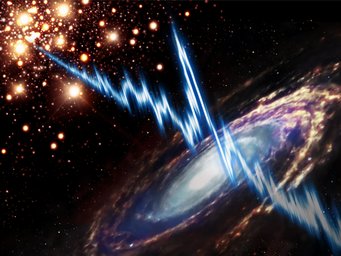Cosmic radio flashes in an unusual location
Researchers locate the source in a globular cluster of the galaxy M81

Most of the fast radio flashes appear as if from nowhere, a few repeat periodically. Each of these bursts emits as much energy as the sun radiates in an entire day. Several hundred of these cosmic flashes are fired every day, and they have been observed all over the sky. Most are located at great distances from Earth – in galaxies billions of light years away.
Researchers led by Franz Kirsten (Chalmers University, Sweden) and Kenzie Nimmo (University of Amsterdam) have now taken a closer look at a source of repeating lightning detected in January 2020 in the constellation of the Ursa Major. "We wanted to look for clues about the origins of the bursts," says Kirsten.
To this end, the scientists used the European observation network EVN. They combined the data from 12 parabolic antennas – including the 100-metre telescope of the Max Planck Institute for Radio Astronomy as the most sensitive single instrument – and were thus able to pinpoint exactly where in the sky the burst of radiation originated.
The team tracked the flashes to the outskirts of the nearby spiral galaxy Messier 81 (M 81), which is about 12 million light years away from Earth – and thus represents the closest source of radio flashes to date. And: their position coincides exactly with a globular cluster that lies in the galaxy and consists of a dense collection of very old stars.
It is precisely this fact that surprises the researchers, because so far FRBs have been found further out in the universe in places where the stars are much younger. "The similarity of the outburst to the emission of some pulsars in our Galaxy puts us on familiar ground, but also makes it clear that the precursors of the radiative outburst can be very different," says Ramesh Karuppusamy from the Max Planck Institute for Radio Astronomy in Bonn.
To understand the surprise, you need to know the theory behind the cause of the radio bursts. Many experts think that so-called magnetars are behind them. These are very dense remnants of exploded massive suns - neutron stars about 20 kilometres in size that rotate rapidly and have extremely strong magnetic fields. "We expect magnetars to be young objects," says Jason Hessels from the University of Amsterdam.
The researchers therefore believe that the source of the radio flashes from the galaxy M 81 is an object that has been predicted theoretically but never seen live before: a magnetar that formed when a white dwarf had accumulated enough mass to collapse under its own weight. "Strange things happen over the course of a globular cluster's several billion years of existence. We suspect that we are looking at a star with an unusual history," says Franz Kirsten.
White dwarfs are considered the final stages of normal stars like our Sun, which live for several billion years and eventually turn into dense objects about the size of the Earth without exploding. Many of these white dwarfs exist in old star clusters, some of them in double star systems. Some of these pairs should come so close that one partner picks up material from the other.
If one of the white dwarfs picks up enough extra mass from its companion, it can turn into an even denser star - a magnetar. "This is a rare event, but in a cluster of old stars it would be the easiest way to produce fast radio bursts," says team member Mohit Bhardwaj from McGill University in Canada.
During their measurements, the researchers made another discovery: some of the bursts were shorter than expected and changed their brightness within just a few dozen nanoseconds. "This means they must come from a tiny volume in space, smaller than a football field and maybe only a few tens of metres across," says Kenzie Nimmo.
Similar ultra-short signals are also received from one of the most famous objects in the sky, the pulsar in the Crab Nebula. This is also a neutron star, i.e. the dense remnant of a supernova explosion that was sighted from Earth in the constellation Taurus in 1054. As the star rotates rapidly on its axis, it emits two beams of radiation. When they pass over Earth, the object appears to be a pulsar, blinking like a lighthouse.
“Some of the signals we measured are short and extremely powerful, in just the same way as some signals from the Crab pulsar. That suggests that we are indeed seeing a magnetar, but in a place that magnetars haven’t been found before”, says Kenzie Nimmo.
Future observations of this and other systems should help determine whether the source is indeed a magnetar or something else, such as a pulsar with unusual properties. Or even a black hole orbited by a compact star in a tight orbit.
HOR












